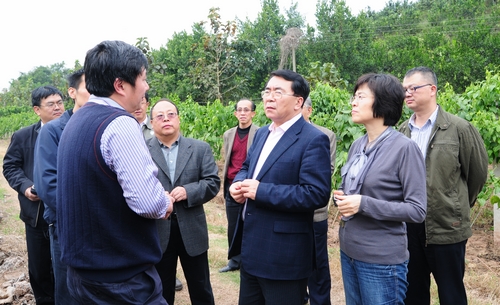Prof. Bai Chunli, President of the Chinese Academy of Sciences (CAS) made an inspection tour to Xishuangbanna Tropical Botanical Garden (XTBG) on December 24.
Prof. Bai Chunli firstly inspected the Nursery and the cultivation base of Inca Peanut (Plukenetia volubilis) and physic nut tree (Jatropha curcasL.). He was briefed the research planning and progress relating the two oil plants.
Afterwards, Bai Chunli visited the living collections and planted a tree of Vatica odorata (Griff) Symington in the Commemorative Plant Garden.
Bai Chunli also inspected the Central Laboratory of XTBG. Ms. FU Yun, director of the laboratory briefed its scale and management.
Prof. Chen Jin, director of XTBG, presented a report on the development since the “Innovation Phase III”, including scientific research, team building, infrastructure construction, innovation culture, species conservation, scientific popularization, and the cooperation between XTBG and local authorities. He also introduced the 12th 5-year plan and “Innovation 2020” of XTBG.
Prof. Bai Chunli gave a high appraisal on the achievements made by XTBG over the past years. He pointed out that XTBG should try to become one of the regional conservation leaders and a research and conservation base for national strategic tropical plant resources. He also encouraged XTBG to make itself into world-class botanical garden by 2020.
During the inspection, Prof. Bai Chunli also held talks with administrative leaders and some research professors, including Mr. Li Hongwei, Prof. Cao Min, Prof. Li Qingjun, Prof. Xu Zaifu, etc.
Prof. Bai Chunli inspired XTBG staff by writing down the XTBG's spirit which is recognized as “responsibility, reality, sincerity and harmony”.
Accompanying the visit were Ms. LI Ting, head of CAS General Office, Prof. Su Ronghui, deputy director of CAS Bureau of Life Sciences & Biotechnology, Prof. Wang Qingli, president of CAS Kunming Branch, and Mr. Li Lei, CPC secretary of CAS Kunming Branch, etc.

At the cultivation base of physic nut tree (Jatropha curcasL.)

At the cultivation base of Inca Peanut (Plukenetia volubilis)


